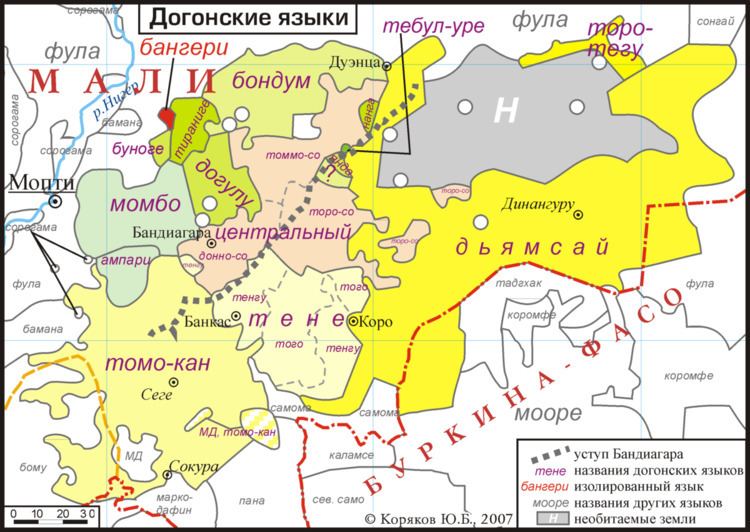Glottolog: dogo1299 | ||
 | ||
Linguistic classification: Niger–Congo?(unclassified)Dogon | ||
The Dogon languages are a small, close-knit language family spoken by the Dogon of Mali, which are generally believed to belong to the larger Niger–Congo family. There are about 600,000 speakers of a dozen languages. They are tonal languages -- most, like Dogul, having two tones; some, like Donno So, having three. The basic word order is subject–object–verb.
Contents
Classification
The evidence linking Dogon to the Niger–Congo family is weak, and their place within the family, assuming they do belong, is not clear. Various theories have been proposed, placing them in Gur, Mande, or as an independent branch, the last now being the preferred approach. The Dogon languages show no remnants of the noun class system characteristic of much of Niger–Congo, leading linguists to conclude that they likely diverged from Niger–Congo very early.
Roger Blench comments,
Dogon is both lexically and structurally very different from most other [Niger–Congo] families. It lacks the noun-classes usually regarded as typical of Niger–Congo and has a word order (SOV) that resembles Mande and Ịjọ, but not the other branches. The system of verbal inflections, resembling French is quite unlike any surrounding languages. As a consequence, the ancestor of Dogon is likely to have diverged very early, although the present-day languages probably reflect an origin some 3–4000 years ago. Dogon languages are territorially coherent, suggesting that, despite local migration histories, the Dogon have been in this area of Mali from their origin.and,
Dogon is certainly a well-founded and coherent group. But it has no characteristic Niger–Congo features (noun-classes, verbal extensions, labial-velars) and very few lexical cognates. It could equally well be an independent language family.The Bamana and Fula languages have exerted significant influence on Dogon, due to their close cultural and geographical ties.
Blench (2015) suggests that Bangime and Dogon languages may have a substratum from a "missing" branch of Nilo-Saharan that had split off relatively early from Proto-Nilo-Saharan, and tentatively calls that branch "Plateau."
Languages
The Dogon consider themselves a single ethnic group, but recognize that their languages are different. In Dogon cosmology, Dogon constitutes six of the twelve languages of the world (the others being Fulfulde, Mooré, Bambara, Bozo, and Tamasheq). Jamsay is thought to be the original Dogon language, but the Dogon "recognise a myriad of tiny distinctions even between parts of villages and sometimes individuals, and strive to preserve these." (Hochstetler 2004:18)
The best-studied Dogon language is the escarpment language Toro So (Tɔrɔ sɔɔ) of Sanga, due to Marcel Griaule's studies there and because Toro So was selected as one of thirteen national languages of Mali. It is mutually intelligible with other escarpment varieties. However, the plains languages—Tene Ka, Tomo Ka, and Jamsay, which are not intelligible with Toro so—have more speakers, and Jamsay and Tommo so are most conservative linguistically.
Calame-Griaule appears to have been the first to work out the various varieties of Dogon. Calame-Griaule (1956) classified the languages as follows, with accommodation given for languages which have since been discovered (new Dogon languages were reported as late as 2005), or have since been shown to be mutually intelligible (as Hochstetler confirmed for the escarpment dialects). The two standard languages are asterisked.
Douyon and Blench (2005) report an additional variety, which is as yet unclassified:
Blench noted that the plural suffix on nouns suggests that Budu is closest to Mombo, so it's been tentatively included as West Dogon above. He also notes that Walo–Kumbe is lexically similar to Naŋa; Hochstetler suspects it may be Naŋa. The similarities between these languages may be shared with Yanda. These are all extremely poorly known.
Pre-Dogon language
Bangi-me (aka Baŋgɛri mɛ), formerly considered a divergent branch of Dogon, turns out not to be Dogon at all, and is possibly a language isolate (Blench 2005b). Blench believes that it is a remnant of the pre-Dogon languages of the area; the Dogon appear to have been in the area for many thousand years.
